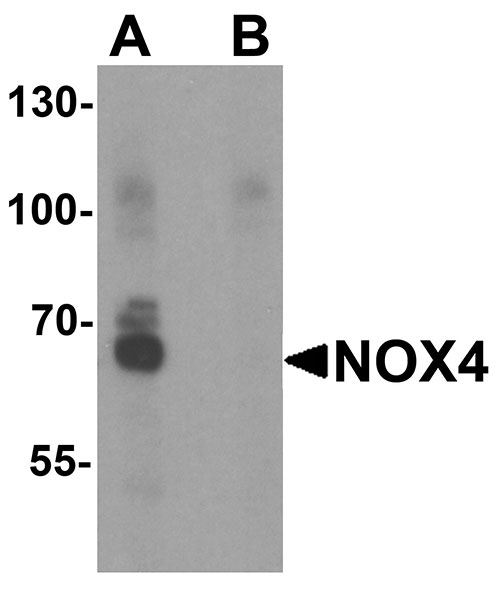NOX4 Antibody
- SPECIFICATION
- CITATIONS
- PROTOCOLS
- BACKGROUND

Application
| WB, IHC-P, IF, E |
|---|---|
| Primary Accession | Q9NPH5 |
| Other Accession | NP_058627, 8393843 |
| Reactivity | Human, Mouse, Rat |
| Host | Rabbit |
| Clonality | Polyclonal |
| Isotype | IgG |
| Calculated MW | Predicted: 64 kDa Observed: 68 kDa |
| Application Notes | NOX4 antibody can be used for detection of NOX4 by Western blot at 1 - 2 µg/ml. Antibody can also be used for Immunohistochemistry starting at 5 µg/mL. For immunofluorescence start at 20 µg/mL. |
| Gene ID | 50507 |
|---|---|
| Target/Specificity | NOX4; NOX4 antibody is human, mouse, and rat reactive. At least four isoforms of NOX4 are known to exist. NOX4 is predicted to not cross-react with other NOX proteins. |
| Reconstitution & Storage | NOX4 antibody can be stored at 4℃ for three months and -20℃, stable for up to one year. |
| Precautions | NOX4 Antibody is for research use only and not for use in diagnostic or therapeutic procedures. |
| Name | NOX4 |
|---|---|
| Synonyms | RENOX |
| Function | NADPH oxidase that catalyzes predominantly the reduction of oxygen to H2O2 (PubMed:14966267, PubMed:15356101, PubMed:15927447, PubMed:21343298, PubMed:25062272). Can also catalyze to a smaller extent, the reduction of oxygen to superoxide (PubMed:10869423, PubMed:11032835, PubMed:15155719, PubMed:15572675, PubMed:15927447, PubMed:16019190, PubMed:16179589, PubMed:16230378, PubMed:16324151, PubMed:25062272). May function as an oxygen sensor regulating the KCNK3/TASK-1 potassium channel and HIF1A activity (PubMed:16019190). May regulate insulin signaling cascade (PubMed:14966267). May play a role in apoptosis, bone resorption and lipolysaccharide-mediated activation of NFKB (PubMed:15356101, PubMed:15572675). May produce superoxide in the nucleus and play a role in regulating gene expression upon cell stimulation (PubMed:16324151). Promotes ferroptosis, reactive oxygen species production and reduced glutathione (GSH) levels by activating NLRP3 inflammasome activation and cytokine release (PubMed:39909992). |
| Cellular Location | Cytoplasm. Endoplasmic reticulum membrane; Multi-pass membrane protein. Cell membrane; Multi-pass membrane protein. Cell junction, focal adhesion {ECO:0000250|UniProtKB:Q924V1}. Nucleus [Isoform 3]: Cytoplasm. Cytoplasm, perinuclear region [Isoform 6]: Cytoplasm. Cytoplasm, perinuclear region |
| Tissue Location | Expressed by distal tubular cells in kidney cortex and in endothelial cells (at protein level). Widely expressed. Strongly expressed in kidney and to a lower extent in heart, adipocytes, hepatoma, endothelial cells, skeletal muscle, brain, several brain tumor cell lines and airway epithelial cells |

Thousands of laboratories across the world have published research that depended on the performance of antibodies from Abcepta to advance their research. Check out links to articles that cite our products in major peer-reviewed journals, organized by research category.
info@abcepta.com, and receive a free "I Love Antibodies" mug.
Provided below are standard protocols that you may find useful for product applications.
Background
The NOX family of NAPDH oxidases is comprised of seven transmembrane proteins that oxidize intracellular NAPDH/NADH, causing electron transport across the membrane and the reduction of molecular oxygen to superoxide (1). NOX4 is is expressed in multiple tissues and catalyzes the reduction of molecular oxygen to various reactive oxygen species (ROS) (2,3). Unlike other NOX proteins, NOX4 does not require cytosolic subunits and thus is constitutively active (4). The function of NOX4 remains unclear as it plays both protective and deleterious roles in cellular metabolism.
References
Bedard K and Krause KH. The Nox family of ROS-generating NAPDH oxidases: physiology and pathophysiology. Physiol. Rev. 2007; 87:245-313.
Cheng G, Cao Z, Xu X, et al. Homologs of gp91phox: cloning and tissue expression of Nox3, Nox4, and Nox5. Gene 2001; 269:131-40.
Montezano AC, Burger D, Ceravolo GS, et al. Novel Nox homologues in the vasculature: focusing on Nox4 and Nox5. Clin. Sci. 2011; 120:131-41.
Martyn KD, Frederick LM, von Loehneysen K, et al. Functional analysis of Nox4 reveals unique characteristics compared to other NAPDH oxidases. Cell. Signal. 2006; 18:69-82.
If you have used an Abcepta product and would like to share how it has performed, please click on the "Submit Review" button and provide the requested information. Our staff will examine and post your review and contact you if needed.
If you have any additional inquiries please email technical services at tech@abcepta.com.













 Foundational characteristics of cancer include proliferation, angiogenesis, migration, evasion of apoptosis, and cellular immortality. Find key markers for these cellular processes and antibodies to detect them.
Foundational characteristics of cancer include proliferation, angiogenesis, migration, evasion of apoptosis, and cellular immortality. Find key markers for these cellular processes and antibodies to detect them. The SUMOplot™ Analysis Program predicts and scores sumoylation sites in your protein. SUMOylation is a post-translational modification involved in various cellular processes, such as nuclear-cytosolic transport, transcriptional regulation, apoptosis, protein stability, response to stress, and progression through the cell cycle.
The SUMOplot™ Analysis Program predicts and scores sumoylation sites in your protein. SUMOylation is a post-translational modification involved in various cellular processes, such as nuclear-cytosolic transport, transcriptional regulation, apoptosis, protein stability, response to stress, and progression through the cell cycle. The Autophagy Receptor Motif Plotter predicts and scores autophagy receptor binding sites in your protein. Identifying proteins connected to this pathway is critical to understanding the role of autophagy in physiological as well as pathological processes such as development, differentiation, neurodegenerative diseases, stress, infection, and cancer.
The Autophagy Receptor Motif Plotter predicts and scores autophagy receptor binding sites in your protein. Identifying proteins connected to this pathway is critical to understanding the role of autophagy in physiological as well as pathological processes such as development, differentiation, neurodegenerative diseases, stress, infection, and cancer.




